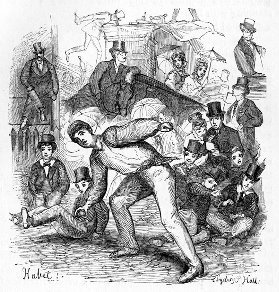To live during this time, one would get the impression that the English invented sports; they certainly behave as if they did. As with fashion, pastimes also fluctuated from time-to-time. An example of this is prize fighting, once popular with the aristocrats, now almost entirely patronized by the working class while horse-racing remains the "Sport of Kings".
If a boy learns anything, it is how to participate on the sporting field. Despite their backwardness in the ballroom, they are ready to compete at other forms of play such as polo, tennis, cricket. The women work off their surplus energy at archery and croquet.
 Despite the popularity of sports, only a few events attained the status as Society functions. One of these is the annual cricket match between Eton and Harrow. It started with the parents attending the match and taking refreshments with them and eventually turned into a large Society picnic. (Picture: Eton-Harrow Cricket Match by Sydney Hall)
Despite the popularity of sports, only a few events attained the status as Society functions. One of these is the annual cricket match between Eton and Harrow. It started with the parents attending the match and taking refreshments with them and eventually turned into a large Society picnic. (Picture: Eton-Harrow Cricket Match by Sydney Hall)
The attendees will arrive the day before and set up in the spots assigned to them in rows of three and four deep. From their carriages, they will dine on cold lunches and drink champagne (not unlike the 21st century's tailgating parties). When possible a hot meal will be served and as always, there is always that time of day for tea.
The Henley Regatta
After the Ascot, the next most important event is the Henley. Although there are many regattas held on the Thames, the Henley offers a location closer to London with a very suitable date which Society adopted and made their own. From a small rural festival, it has grown to the proportions of a national holiday. (Picture: Henley the Finish, Anonymous)
offers a location closer to London with a very suitable date which Society adopted and made their own. From a small rural festival, it has grown to the proportions of a national holiday. (Picture: Henley the Finish, Anonymous)
The uniqueness of the Henley is that there is no distinction made between those who are looked at and those who look on. Everyone plays a part in a panoramic setting of color and movement.
The rules governing Henley are strictly enforced. It begins with a governing committee or board of trustees, who long before the Henley, receive applications from clubs for places along the bank and from families for portions of the lawns and from the owners of houseboats for positions along the course.
The racing is just a small part of the event. Only two boats at a time can race. It can be described as more of a large picnic held on and by the water's edge where the boaters and thousands of people all come together to celebrate the outdoors . . . the green trees, the flowers, even the lanterns at night and the fireworks add to the gloriousness of this event.
|
|
|
|
|
|
|
|
|
|
|
|
Back to Intro/Index or Site Map
| | Family Gallery | Servants Parlour | Tour Home | Typical Day | Etiquette | Shopping Trip | |
| | Victorian Christmas | Victorian England Fun and Games | Ashton Library | Victorian Wedding | |
| | Victorian England Overview | Guest Registry | Honorary Victorian | Tours | |
| | Awards Received | Bibliography | |
| | 1876 Victorian England Home | |
Credits below copyright information |
| Contact
webmaster |
| Copyright
1999-2017 All Rights Reserved - B. Malheiro May not be reproduced in any way without express written permission of webmaster. |
Background and buttons are the creation of webmaster, B. Malheiro. These images are digitally watermarked and not for use on another site. The other images are from cd's and various newsgroups.